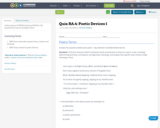
A short quiz on CCSS.ELA-Literacy.CCRA.R.4. All questions but one are multiple choice.
- Subject:
- Arts and Humanities
- Material Type:
- Assessment
- Date Added:
- 12/13/2013

A short quiz on CCSS.ELA-Literacy.CCRA.R.4. All questions but one are multiple choice.

A short quiz on CCSS.ELA-Literacy.RL.9-10.4, featuring a passage from O. Henry's short story, "The Gift of the Magi". The passage has a Dale-Chall text difficulty level of 5-6, and a Flesch-Kincaid level of 5.0.

Students will paraphrase and summarize a key scene from Romeo & Juliet in writing, working both in groups and individually.
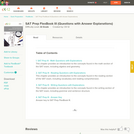
A free mini-book to prepare students for the SAT exam with lessons and questions in math, reading, and writing.
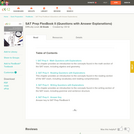
A free mini-book to prepare students for the SAT exam with lessons and questions in math, reading, and writing.

This introduces William Shakespeare's language by providing students with an opportunity to examine phrases and sayings first written in his plays. Students will read an informational text as well as spend time researching various Shakespearean phrases and their presence in his plays to determine his continuing relevance in modern language today. Students will be able to apply Shakespearean phrases to modern situations in order to determine his relevance.
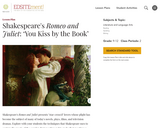
As one of literature's most iconic figures, both Shakespeare's plays and poetry provide an interesting glimpse into a variety of essential themes. In this lesson, students will examine how Shakespeare used the sonnet tradition to enhance his stagecraft by performing a scene from his play Romeo and Juliet.
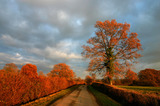
This lesson uses images and the "I See...and I Wonder" strategy to get students thinking about the bigger concepts that objects might represent. Students often see symbols as mere objects with only a only face value because of the speed with which they encounter them. However, if we can encourage students to take more time to study an object, other concepts or meanings can come to light.This lesson uses images as an entry point to symbolism because they are less threatening than literature. The images provided are a starting place, but feel free to remix and use your own images. This journaling activity is about writing (and discussing) to learn. It can be graded or just formative. Either way, items to assess would include:Do students really dig into the details, both large and small?Are they being thorough "readers" of the image in the quality of their "wondering"? There is no length requirement, but the timer recommendations do communicate an expectation that responses to be more than just a sentence or two or a very brief list.For task 2, do students begin to make some interpretive claims? Are those claims valid? Are they grounded in the details?If students are struggling to make interpretive claims that make sense with the image, back up and do another image in small groups that might allow more modeling, deeper thinking prompts, or even questioning the students to better understand their interpretations.If students are successful with the images, transition to a short peice of text like a poem. Students can use the same process of "I See...and I Wonder." The Task 2 questions can be slightly modified to apply to text rather than image.

In this assignment, students will read and analyze the article "Teenage Brain" by David Dobbs. Students will also practice using context clues to decipher word meaning and consult a dictionary to verify accuracy. Lastly, students will consider how the ideas conveyed in the article apply to Romeo and Juliet's rash actions in Shakespeare's play, Romeo and Juliet

First, students will read and analyze NPR's interview with Dr. Frances Jensen, "Why Teens are Impulsive, Addition-Prone And Should Protect Their Brains."Students will then compare and contrast this reading with the article they previously read, "Teenage Brain." Students applied the ideas conveyed in "Teenage Brain" to Romeo and Juliet's rash actions in Shakespeare's play, Romeo and Juliet.Lastly, students will practice using context clues to decipher word meaning and consult a dictionary to verify the accuracy.